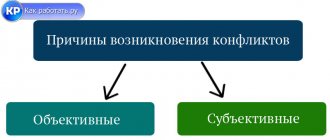A primitive form of communication
The interlocutor is regarded as a sought-after or, conversely, interfering object. For example, if a person is needed in a certain situation, then they willingly have a conversation with him, but if on the contrary, then they do not want to communicate with him or speak in a rude manner. An example of a primitive type of communication is a conversation with a person who is intoxicated. A limited vocabulary and accelerated speech rate are characteristics of this species. A citizen faced with a primitive type of communication should maintain a neutral environment and not enter into conflict with the interlocutor.
Personality types: let's discuss everything in person
This is perhaps one of the most wonderful personality types I have ever met in business. The person is open to dialogue, behaves at ease, positively, and is ready to listen and talk. You won’t find out much over the phone, and they may immediately ask you to meet in the office. Upon arrival at the office, you will meet a smiling person who will offer to address you on a first-name basis, will talk, discuss, gesticulate a lot, and then offer to end the conversation in an informal setting. You may think that you have known this person for several days, because in a few hours a trusting, friendly relationship can develop. Believe me, if your proposal interests this person, he will immediately say so, and will not play any behind-the-scenes games, weave intrigues, or try to extract the most favorable agreement.
Communication tactics:
Why do you think it is easy to communicate with such people? That's right, because this type of personality presupposes honesty, openness, and trust. From the first minutes the interlocutor already considers you as a potential partner, and you should not be disingenuous with him or hide something. Be as open as possible, behave casually, do what you would do in a normal environment, and not at a business meeting. This will only emphasize your readiness to work with this type of people, and will arouse additional trust in your interlocutor.
Manipulative type of communication
This type of communication is intentionally focused on obtaining benefits from the conversation. The interlocutor uses various methods: lies, intimidation, or, conversely, tries to demonstrate flattering kindness. This type of communication is widespread among managers and sellers who intend to sell a product that no one needs by any means and tricks. They can talk with a smile about how other customers were satisfied, although in reality everything looks different.
Type three: “Corrosive and meticulous”
Characteristics: thinks and speaks slowly, drawing out words. If you are ready to communicate, it means that you have already collected as much information as possible regarding the topic of negotiations, you and your company. Therefore, you need to know the subject of the conversation thoroughly. If you warned that the dialogue would last 30 minutes, then in exactly half an hour he will stop listening to you. When saying goodbye, he will ask you to write and send him a list of the issues discussed. At the same time, keep in mind: he may forget everything you talked about. But the contents of the letter will be remembered for a long time. Before making a final decision, he will take a time out to think everything over again and... get the approval of a third party. This will require several more meetings. Perhaps with the involvement of specialists from his and your company. So be patient.
Communication tactics
Become a complete reflection of him: speak at an average pace and only to the point. Answer the questions asked clearly. Do not interrupt him or be late for the meeting under any circumstances. After negotiations, pay special attention to the final letter!..
Type of business communication
This is communication during which the interlocutors take into account age, position in society, character traits and even mood. But with all this, interest in a business or project is much more important than the above. The level of business communication is needed mainly in a work environment or in situations where it is necessary to maintain a professional distance from the interlocutor. This type of communication is designed for mutual respect and serious conversations.
Non-initiative type
People who can be classified as this type are rarely the first to take the initiative in the communication process. But communication with them turns out to be very pleasant and easy, since they are organically located within the communicative context. Their main function is to maintain communication, and they succeed almost perfectly in this.
It is easy to communicate with individuals of the non-initiative type, despite their certain passivity, since they are excellent listeners, directing and “igniting” communication with remarks like: “Really?”, “Well, yes?!” etc., while showing sincere interest in the interlocutor’s reaction. The peculiarity of people of this type of communication is a well-developed ability to feel their communication partner and create a favorable emotional background for the communication process.
Game type of communication
One of the most popular types of communication. It can be observed among a group of peers. The level of gaming communication assumes the informality of the conversation. All kinds of jokes and frivolous topics of conversation are appropriate here. During such a conversation, the interlocutors, for example, give advice to each other, tell life stories, declare their love, plan and discuss how to spend the weekend, etc. As a rule, only positive and positive emotions remain from this type of communication.
Spiritual type of communication
This type is otherwise called interpersonal , for example, you can take a conversation between friends. This implies communication on various topics, when one’s thoughts, feelings and emotions can be expressed not only through conversation, but also through gestures, intonation, facial expressions and other manipulations.
This communication is possible only if the interlocutor clearly imagines the image of the other participant in the conversation and is well acquainted with him personally, since during such a conversation it is necessary to know the interests of the interlocutor and anticipate his reaction in various situations. The spiritual type of communication also involves revealing one’s personality and one’s spiritual world to the other participant in the conversation . Such conversations take place in a friendly atmosphere, and the relationship between the interlocutors is based on trust in each other.
A distinctive feature of this type of communication is the accompanying facts that are conducive to a confidential conversation. This is measured and unhurried speech. This type of spiritual communication can be observed when communicating with parents and close relatives, between husband and wife, etc.
Communication is...
Communication is a connection between people, during which psychological contact appears. It manifests itself in mutual influence, -understanding, -experience, and in the exchange of information, thoughts, ideas, emotions.
In the modern world, the scale of data that needs to be urgently transferred to someone has increased significantly. Therefore, the intensity and importance of communication increases, and along with this, the methods for implementation (messengers, video calls, etc.).
Communication in psychology is 3 important aspects that are intertwined:
- The purpose is the reason for which contact and information transfer occur. Animals that also communicate can transmit an alarm signal to warn that danger is nearby. Or for the primitive attraction of a sexual partner. Thus, they satisfy their biological needs. As for a person, communications can be cultural, social, aesthetic, creative, cognitive - for the growth and development of the individual.
- Content - This is the data that is transmitted during communication. In the animal world, this is, for example, information that there is food nearby.
For people, the object of conversation can be very different. May include a skill or experience, feelings that are conveyed to each other.
- Media is a way of transmitting information. Since communication is not only words and the use of language (what is that?), writing. Signals can also be transmitted using smells, a visual component, or by touching another person.
"Contact of masks"
Absolutely all people, without noticing it themselves, use this type of communication. Example: when meeting friends, they smile, even without meaning to. If a person does not want to reveal his essence to another participant in the conversation, express his real attitude towards him, or be frank, then almost always he, as it were, “puts on a mask” that hides his true attitude towards the interlocutor. After all, there are often situations when you have to behave civilly and politely with a person who is very unpleasant. Most likely, every person can remember some life situation when he had to “put on a mask.”
In various life situations, people use almost all types of communication. It is important to remember that in communication you need to be able not only to speak, but also to listen.
Types and functions of communication
ETHICAL AND PSYCHOLOGICAL FOUNDATIONS OF BUSINESS COMMUNICATION
Plan
3.1. Types and functions of communication.
3.2. Communication barriers.
3.3. Communication techniques and techniques for overcoming communication barriers.
Key words : communication, psychology, communication barrier, information.
There are two main types of social contacts: activity and communication. There are differences between communication and activity, as types of human activity. The result of an activity is usually the creation of some material or ideal object or product (for example, the formulation of a thought, idea, statement). The result of communication is the mutual influence of people on each other. Both activity and communication should be considered as interconnected aspects of social activity developing a person.
In real human life, communication and activity as specific forms of social activity appear in unity, but in a certain situation they can be realized independently of each other. The content of the category of communication is diverse: it is not only a type of human activity, but also a condition and the result of this same activity; exchange of information, social experience, feelings, moods.
Communication is characteristic of all higher living beings, but at the human level it takes on the most perfect forms, becoming conscious and mediated by speech. There is not even the shortest period in a person’s life when he is out of communication, out of interaction with other subjects.
The content of communication is information that is transmitted from one living being to another in inter-individual contacts. The content of communication can be information about the internal motivational or emotional state of a living being. The content of communication can be information about the state of the external environment, for example, signals of danger or the presence of positive, biologically significant factors, such as food, somewhere nearby.
In humans, the content of communication is much broader than in animals. People exchange information with each other that represents knowledge about the world: rich, lifetime experience, knowledge, abilities, skills and abilities. Human communication is multi-subject, it is the most diverse in its internal content.
In terms of content, communication can be presented as:
— Material – exchange of products and objects of activity, which in turn serve as a means of satisfying the actual needs of subjects.
— Cognitive – knowledge sharing.
- Active - exchange of actions, operations, abilities, skills. Here, information is transmitted from subject to subject that expands horizons, improves and develops abilities.
— Conditional – exchange of mental or physiological states.
— Motivational – exchange of motivations, goals, interests, motives, needs. Motivational communication has as its content the transfer to each other of certain motivations, attitudes or readiness to act in a certain direction.
The purpose of communication is what a person does for this type of activity. If in animals the goals of communication usually do not go beyond satisfying their biological needs, then in humans they are a means of satisfying many different needs: social, cultural, cognitive, creative, aesthetic, the needs of intellectual growth, moral development and a number of others.
According to goals, communication is divided into biological and social:
— Biological is communication necessary for the maintenance, preservation and development of the organism. It is associated with the satisfaction of basic organic needs.
— Social communication pursues the goals of expanding and strengthening interpersonal contacts, establishing and developing interpersonal relationships, and personal growth of the individual.
There are as many private types of communication as there are subtypes of biological and social needs.
Main types of communication:
— Business communication is usually included as a private moment in any joint productive activity of people and serves as a means of improving the quality of this activity. Its content is what people are doing, and not the problems that affect their inner world.
- Personal communication, on the contrary, is focused mainly around psychological problems of an internal nature, those interests and needs that deeply and intimately affect a person’s personality; searching for the meaning of life, determining one’s attitude towards a significant person, towards what is happening around, resolving any internal conflict.
— Instrumental - communication that is not an end in itself, is not stimulated by an independent need, but pursues some other goal other than obtaining satisfaction from the act of communication itself.
— Targeted is communication, which in itself serves as a means of satisfying a specific need, in this case, the need for communication.
Means of communication can be defined as methods of encoding, transmitting, processing and decoding information transmitted in the process of communication from one living being to another.
Encoding information is a way of transmitting it from one to another. Information can be transmitted through direct bodily contacts: touching the body, hands, etc. Information can be transmitted and perceived by people at a distance, through the senses (observation by one person of the movement of another or the perception of sound signals produced by him). Man, in addition to all these natural methods of transmitting information, has many that are invented and improved by him.
This is language and other sign systems, writing in its various types and forms (texts, diagrams, drawings, drawings), technical means of recording, transmitting and storing information (radio and video technology; mechanical, magnetic, laser and other forms of recording). In terms of his ingenuity in choosing means and methods of communication, man is far ahead of all living creatures known to us that live on planet Earth.
The functions of communication are distinguished in accordance with the content of communication.
There are four main functions of communication:
— The instrumental function characterizes communication as a social mechanism for managing and transmitting information necessary to perform an action.
— The integrative function reveals communication as a means of uniting people.
— The function of self-expression defines communication as a form of mutual understanding of the psychological context.
— The translation function acts as a function of transferring specific methods of activity, assessments, etc.
Other functions of communication include : expressive (function of mutual understanding of experiences and emotional states), social control (regulation of behavior and activities), socialization (formation of interaction skills in society in accordance with accepted norms and rules), etc.
Communication is extremely diverse in its forms. We can talk about direct and indirect communication, direct and indirect, mass and interpersonal.
A modern specialist in the field of trade and services has to pay the greatest attention to interpersonal communication in his daily activities, and therefore face certain problems of both a verbal and non-verbal nature.
In accordance with established tradition, in domestic social psychology there are three types of interpersonal communication : imperative, manipulation and dialogue.
— Imperative communication is an authoritarian, directive form of influencing a communication partner in order to achieve control over his behavior and internal attitudes, forcing him to take certain actions or decisions. In this case, the communication partner is considered as an object of influence and acts as a passive, “suffering” party. The peculiarity of the imperative is that the ultimate goal of communication - coercion of a partner - is not veiled. Orders, instructions, instructions and demands are used as means of exerting influence.
— Manipulation is a common form of interpersonal communication that involves influencing a communication partner in order to achieve one’s hidden intentions. Like the imperative, manipulative communication presupposes an objective perception of the communication partner, who is used by the manipulator to achieve his goals. They are also related by the fact that during manipulative communication the goal is also to achieve control over the behavior and thoughts of another person. The fundamental difference is that the partner is not informed about the true goals of communication; they either simply hide from him or are replaced by others.
— Dialogical communication is communication that allows you to move from an egocentric, self-fixated attitude to an attitude towards the interlocutor, a real communication partner.
Dialogue is possible only if the following immutable rules of relationships are observed:
— Psychological attitude towards the current state of the interlocutor and one’s own current psychological state. In this case, we are talking about communication on the “here and now” principle, taking into account the feelings, desires and physical condition that the partners are experiencing at the moment.
— Non-judgmental perception of the partner’s personality, a priori trust in his intentions.
— Perception of a partner as an equal, having the right to his own opinion and his own decision.
— The content of communication should not be truisms and dogmas, but problems and unresolved issues (problematization of the content of communication).
— Personification of communication – speaking on one’s own behalf, without reference to opinions and authorities, presentation of one’s true feelings and desires.
Communication is richer than the communicative process. It connects people not only through the transfer of information, but also through practical actions, an element of mutual understanding.
Information in communication is not simply transferred from one partner to another (the person transmitting information is usually called a communicator, and the person receiving this information is called a recipient), but is exchanged.
Feedback is information containing the recipient’s reaction to the communicator’s behavior. The purpose of feedback is to help a communication partner understand how his actions are perceived and what feelings they evoke in other people.
In the process of communication, the exchange of information between its participants is carried out both at the verbal and non-verbal (non-speech) level .
At the basic, verbal level, human speech is used as a means of transmitting information. It is speech, as a manifestation of the activity of the will and consciousness of the speaker, that is a condition for the spiritual transformation of the individual.
Nonverbal communication includes the perceived appearance and expressive movements of a person - gestures, facial expressions, postures, gait, etc. They are in many ways a mirror that projects a person’s emotional reactions, which we seem to “read” in the process of communication, trying to understand how the other perceives what is happening.










